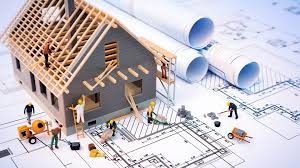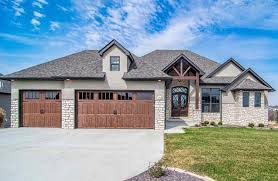Buying New Home Construction From Builders
The idea of buying a brand-new home can be tempting. You won’t inherit someone else’s worn-out carpeting or have to look at some kid’s initials scrawled into once-wet cement. You’ll get a home that’s in line with the latest trends in design and construction, and it should be move-in ready. But there are some downsides and pitfalls involved with buying new home construction directly from the builder.
Consider Hiring an Agent
You don’t have to use a real estate agent to buy new construction, but you can. And you’ll likely encounter a sales agent when you visit a model home or meet with a home builder, someone who’s been hired by the builder to sell properties in that community. You don’t want to be outmatched if you’re not personally experienced in real estate and you’re proceeding without an agent of your own.
Use the Right Lender
Builders often recommend their own preferred mortgage lenders for a variety of reasons. It reduces their costs and helps keep the business—and the profits from that business—in-house. It also makes it easier to keep both parties informed of the transaction’s progress.
In fact, builders sometimes offer special deals and discounts if you use their preferred lender. They might even offer money off your home’s sale price. But don’t jump in with both feet quite yet. Research the lender’s reputation, ratings, and customer service quality first.
Consider alternate sources to find a lender. Your own bank or credit union might offer you very attractive rates and terms based on your banking history with that institution. Your agent might recommend lenders that can help as well…if you hire one.
Get multiple quotes. It’s generally advisable to get quotes from at least three to five lenders. In fact, indicates that getting five quotes can save you an average of $3,000.
Research and interview your lender. Find a banker or mortgage broker you can trust and with whom you feel comfortable doing business. Dig into their background and reviews, too.
Look beyond interest rates. They’re not everything and they don’t tell the whole story. You should also consider the fees each lender is quoting you, as well as the terms, prepayment penalties, and other facets of their loan estimates

Guide to buying a new-build home
New-build homes are a popular option for many people across the country. From first-time buyer homes and bachelor pads, to family houses and retirement homes, there is plenty of choice for buyers.
Buying new-build vs old
There are many advantages to buying a new-build home. Here are some of top reasons
You can get in early
Many house builders and developers offer properties off-plan, which means you can choose and reserve your dream home before it is even built.
You can build it around you
You will be able to make your own mark on a new-build home, knowing that it has been untouched by previous owners. Some house builders and developers offer buyers the opportunity to design their new home from scratch. This could range from the position of doors, cupboards and plug sockets, to the style of the wallpaper, garden landscaping and the colour of your kitchen worktop.
It’s ‘low-mo’ – low maintenance
There is no need to carry out repairs, maintenance and redecorate when you move into a new home. In fact, any such work is likely to be unnecessary for at least the first few years.

HOME BUILDERS GUIDE
BEFORE YOU BUILD
A home is more than lumber, windows, and carpet– it’s selecting the lot, clearing the land, installing the utilities, and on and on throughout the final interior touches. When you build, you want to remember the big picture—not just the structure itself— to ensure you are getting everything you want and staying within your budget guidelines.
Your budget must include the home to be built and everything around it. The lot, the drive way, the taxes and many other factors must be considered when determining what you can afford Location, location, location. You’ve heard it a thousand times, and it’s just as important now. Make sure the lot you purchase is perfectly matched to your needs. You’ll want to consider factors such as size, shape, and accessibility when making the purchase.
Be informed. Gather all the information you can regarding county and /or township zoning laws and building regulations. Check with your future neighbors, they may tip you off on some hidden problems. Arrange for a site evaluation.
Make an informed value decision. Research the type, style and cost comparisons of the home options available to you. These include: pre-cut, panelized and manufactured homes, and well as the custom-built home. The total cost for these types of homes are surprisingly similar when the factors of labor input, materials and equipment/furnishing are all considered. This is where value of a custom-built Nelson Home really comes into play—you get exactly the home you want, and you don’t have to pay expensive design modifications
BUILDING STRATEGY
For the homeowner, the commitment to building a new home can be very demanding. But with the guidance of Nelson Home professionals, the process can be simplified into one successful strategy. Does the home meet value requirements? The value of your new home is based on whether or not it meets your needs and wants, and if it is durable and affordable.
NEW HOME CONSTRUCTION GUIDE
Are you presntly considering purchasing a new construction home? It’s an option that gives you the most control over your property. You’ll be the first person to live in the home, and the entire structure and its contents will be brand-new
What Exactly Is a New Construction Home?
A new construction home is a home that’s built brand-new from the ground up versus an older, upgraded home. The term is a reference to the fact that the people who create the home will become the first-ever inhabitants. That means you can build it how you like, to meet your specific requirements.
With the power of building a new home comes the responsibility of performing research and making decisions. Since you’re in charge of every aspect of your design, it’s worth learning and deciding on all the crucial information about upgrades, building materials, and amenities.
Buying a New Construction Home: What’s Involved?
Purchasing new construction homes will vary by builder and locality, but the process for Homes is as follows: Once an agreement is signed, we immediately process and send it
You’ll then have another session with her within 28 days to finalize selections. Your pre-construction meeting is within 30 days of a signed agreement, and this is with our construction, sales and design teams. You’ll review a full set of large blueprints and go through a detailed agenda along with your contract and addendum so that we can ensure everything is correct before pouring the foundation of your home.
HOME BUYERS GUIDE
Building a new home is exciting and should be a happy time for you and your family. The typical house contains more than 3,000 different parts. All of these components must be assembled with skill in order to meet building codes and make your new home safe. It can be a daunting task if you are not familiar with the construction process. This guide is designed to assist you in asking the right questions of your builder before, during and after the home building experience.
Hire your own inspector
While the builder will schedule a final “walk-throughs” with you, it is important to invest the money in hiring your own home inspector.
Find an inspector that has a good reputation and who will conduct a thorough inspection.
Any offer or contract should be contingent upon (or subject to) a whole-house inspection with a satisfactory report. Get a right-to-inspect in your initial purchase agreement.
Building codes
Research your area’s building codes and certificate of occupancy requirements (remember, some municipalities do not require an inspection prior to move in).
Most new homes must also receive a certificate of occupancy. Request to see your certificate. You can also find the certificate at the city inspector’s office.
Pre-settlement walk-through
Consider having your inspector accompany you on twice-monthly walk-through of the home during the construction phase.
Be wary of any construction agreement that does not allow you on the premises prior to completion.
The walk-through is usually conducted just prior to finalizing your home purchase with the builder. This is a time when you have the opportunity to closely scrutinize the home. You should be observant, carefully examining all surfaces, fixtures, floors and walls for possible damage.
During this walk-through, you should write down a checklist of all the items that need repair before you move in.
Do not agree to close until all items on the checklist have been corrected unless you are willing to do them yourself. Keep a copy of the checklist for yourself.
Grading:
Does the ground around the foundation slope away from the house?
Is the shrubbery placed at least 2-3 feet from the foundation?
Are basement window wells clean and graveled?